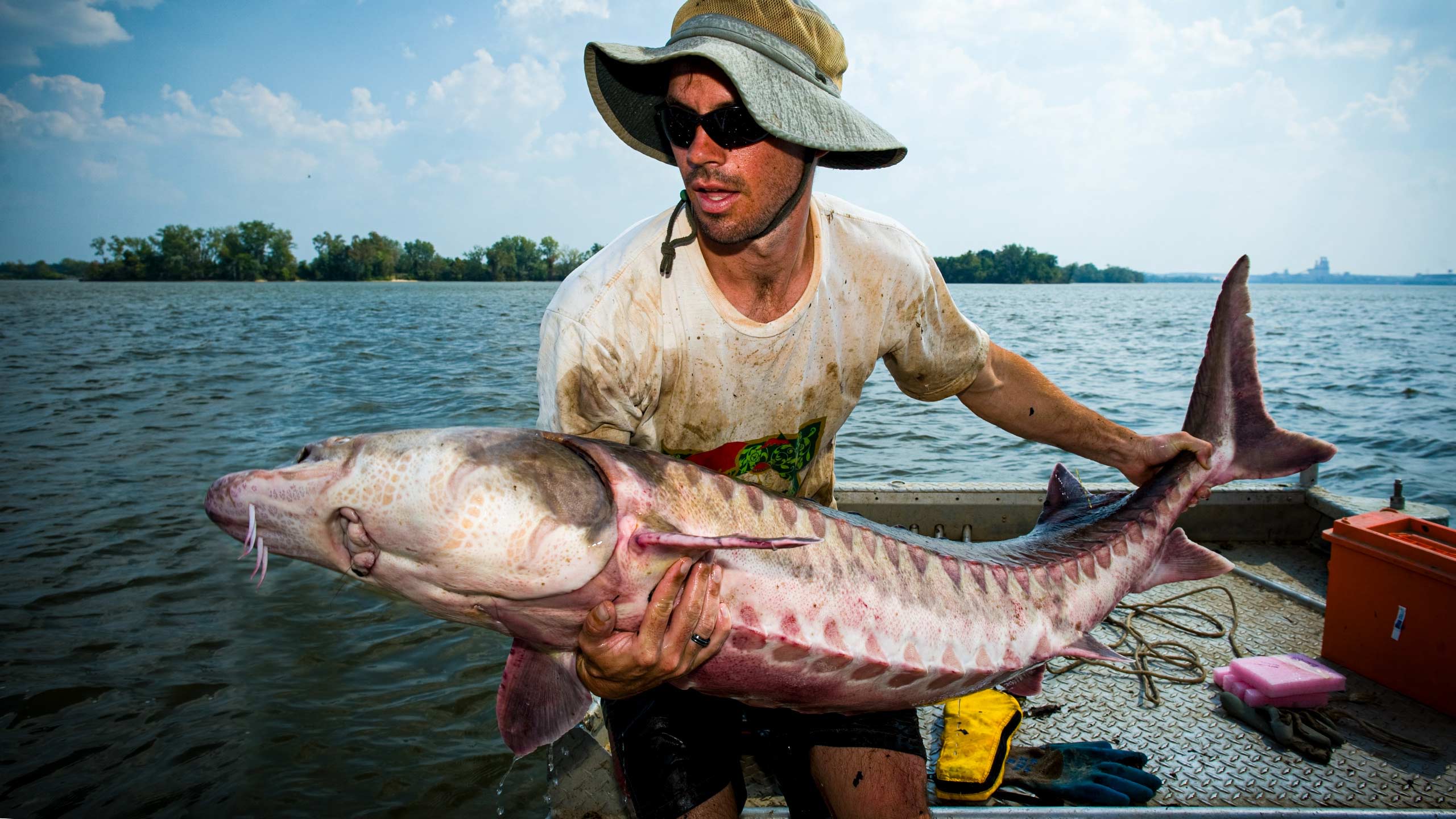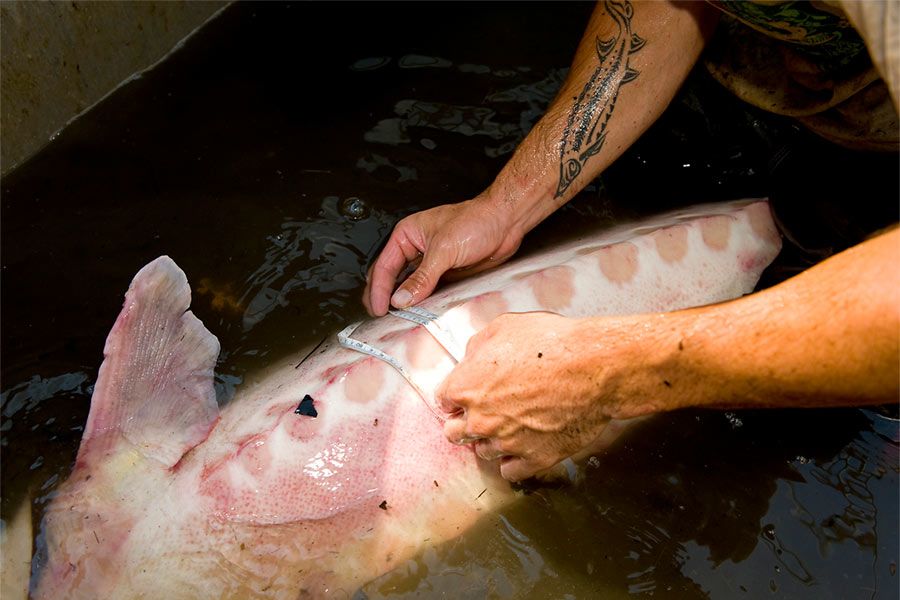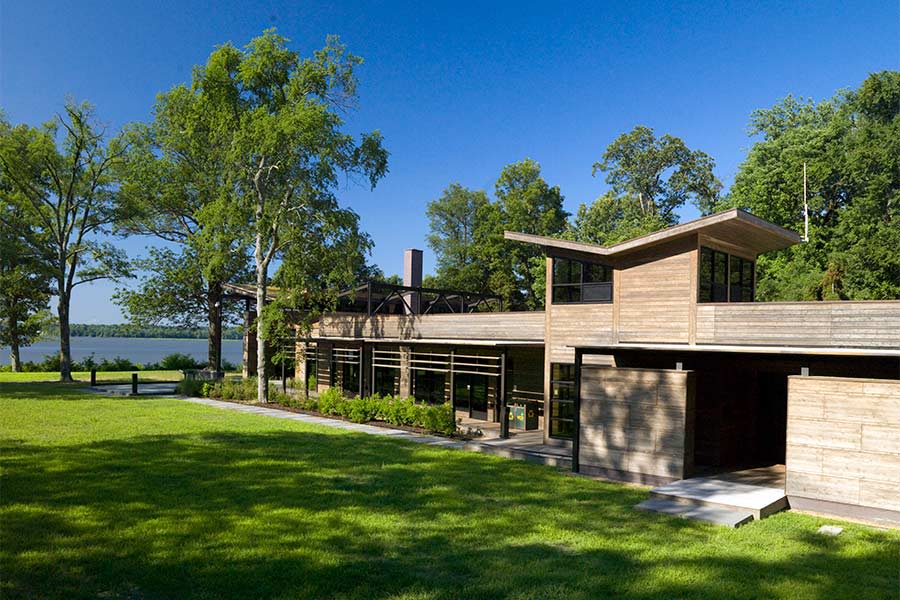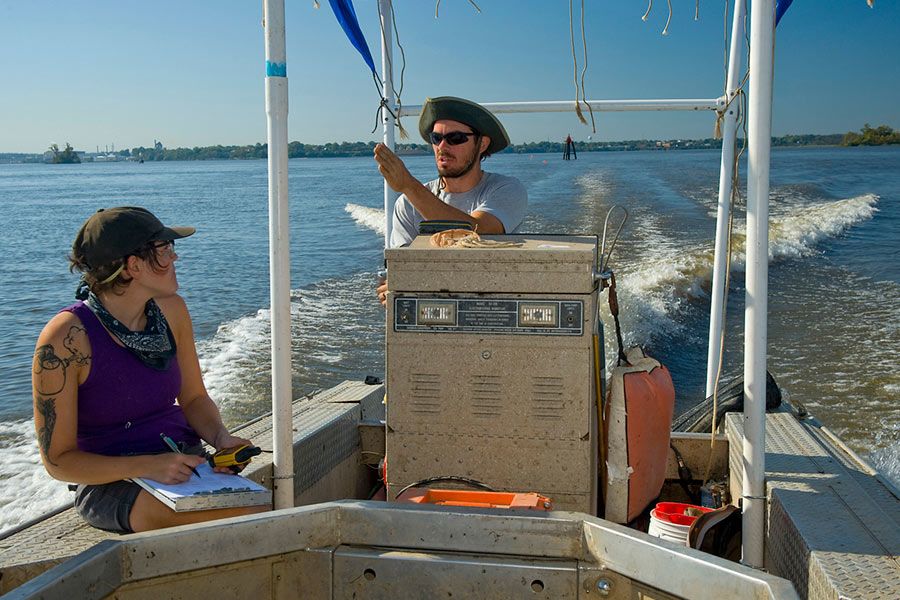UNCOMMON HERO

UNCOMMON HERO

“It’s a big responsibility because people are looking to you for answers to help a cryptic, endangered species. When you scale that up, you don’t realize how big of an impact that small little piece may make.”
–Dr. Matt Balazik, Atlantic Sturgeon Researcher, VCU Rice Rivers Center
Saving a Prehistoric Giant:
One Scientist’s Fight for the Atlantic Sturgeon
For Dr. Matt Balazik, the choice is easy. If he could have any superpower, he wouldn’t choose flight — he’d want to breathe underwater.
“In a heartbeat,” he says.
It’s a fitting answer for someone who has dedicated his career to saving one of North America’s most ancient and enigmatic creatures: the Atlantic sturgeon.
These prehistoric fish, which have been around for more than 140 million years, once thrived in the rivers along the East Coast. Their armored bodies and whisker-like barbels give them a dinosaur-like appearance, and their resilience has carried them through mass extinctions and environmental upheavals. But now, their biggest threat is human activity.
After centuries of overfishing, habitat destruction and pollution, the Atlantic sturgeon population was nearly wiped out. Conservation efforts have helped bring them back from the brink, but researchers like Balazik know there’s still work to be done.
Research That Breaks Boundaries
Balazik’s work is part of something bigger. As a top-ranked research university, VCU is known for tackling complex challenges that others can’t — or won’t. The National Science Foundation ranks VCU among the nation’s top research institutions, recognizing its commitment to discovery and impact
At VCU Rice Rivers Center, a research hub focused on environmental restoration, that innovation is on full display. The team’s cutting-edge research methods — combining genetic studies, satellite tracking and ecological modeling — are not just helping restore the James River sturgeon population but also are influencing international conservation strategies.
“Matt is one of this country’s leading sturgeon researchers,” says Dr. Greg Garman, the center’s director. “He’s already closely connected with other sturgeon biologists in the U.S., but now he’s taking that knowledge and passion to other parts of the world, where they’re hoping to duplicate some of the successes we’ve had.”
A Personal Mission
For Balazik, the fight to save the sturgeon isn’t just professional — it’s also personal. He grew up along the James River, where his family has lived for generations. As a child, he heard stories about the enormous fish, but they seemed more like legends than reality.
Then came a turning point: Albert Spells, a researcher with the U.S. Fish and Wildlife Service, mentioned that small sturgeon were still being caught downstream. Inspired, Balazik set out on a boat.
“Maybe a week later, we were out here on the water, and literally, one just jumped right behind the people I was facing,” he recalls. “That was it. I was like, ‘We need to start doing some work. We need to start figuring this out.’”
Unwavering Dedication
Balazik’s commitment to the species goes beyond research. His dedication to sturgeon is steadfast, no matter the conditions.
“It doesn’t matter how cold it is, what time of day or night, or how difficult the work is,” says Garman. “If there’s science to be done that will help sturgeon, Matt’s on the water doing that job.”
For Balazik, the responsibility is enormous. Sturgeon are a cryptic species, and people look to him for answers. But he also understands that the impact of his work extends far beyond a single species.
“When you scale it up, you don’t realize how big of an impact that small little piece may make,” he says. “There is so much out there to be discovered.”
The Role of Sturgeon in the Ecosystem
While Atlantic sturgeon are rare, their role in the environment is significant. As bottom feeders, they help clean riverbeds, cycle nutrients and control invasive species. Their absence disrupts the balance of aquatic ecosystems, making their conservation vital to the health of the rivers they inhabit.
“The work we do with sturgeon doesn’t just help one species — it helps create cleaner rivers and more resilient coastal environments for future generations,” says Garman.
Balazik and his team use a variety of research techniques, including tagging and tracking individual fish, studying their genetics and monitoring population trends. These efforts have allowed them to learn more about the species’ movements and challenges. Garman emphasizes, “Our mission is to do the science that will lead to better environmental policies and practices that protect species like the sturgeon.”
So far, VCU researchers alone have tagged over 900 adult sturgeon in the James River.
Looking Underneath the Surface
The future of the Atlantic sturgeon is still uncertain, but Balazik and his team are determined to give them a fighting chance. Their research, outreach and dedication are helping to shape policies that will protect not just the sturgeon but also the rivers and ecosystems that rely on them.
One thing is clear: Sometimes, to make a lasting impact and save a species, you have to look beneath the surface.
Balazik may not be able to breathe underwater, but with VCU’s unwavering innovation, that’s exactly where his impact begins.
As a top 20% global university, Virginia Commonwealth University is an unparalleled powerhouse of innovation and creative problem solving. VCU attacks challenges as opportunities to do what others can’t. Or won’t.
It’s truly a university unlike any you’ve ever seen.
For Dr. Matt Balazik, the choice is easy. If he could have any superpower, he wouldn’t choose flight — he’d want to breathe underwater.
“In a heartbeat,” he says.
It’s a fitting answer for someone who has dedicated his career to saving one of North America’s most ancient and enigmatic creatures: the Atlantic sturgeon.
These prehistoric fish, which have been around for more than 140 million years, once thrived in the rivers along the East Coast. Their armored bodies and whisker-like barbels give them a dinosaur-like appearance, and their resilience has carried them through mass extinctions and environmental upheavals. But now, their biggest threat is human activity.
After centuries of overfishing, habitat destruction and pollution, the Atlantic sturgeon population was nearly wiped out. Conservation efforts have helped bring them back from the brink, but researchers like Balazik know there’s still work to be done.
Research That Breaks Boundaries
Balazik’s work is part of something bigger. As a top-ranked research university, VCU is known for tackling complex challenges that others can’t — or won’t. The National Science Foundation ranks VCU among the nation’s top research institutions, recognizing its commitment to discovery and impact
At VCU Rice Rivers Center, a research hub focused on environmental restoration, that innovation is on full display. The team’s cutting-edge research methods — combining genetic studies, satellite tracking and ecological modeling — are not just helping restore the James River sturgeon population but also are influencing international conservation strategies.
“Matt is one of this country’s leading sturgeon researchers,” says Dr. Greg Garman, the center’s director. “He’s already closely connected with other sturgeon biologists in the U.S., but now he’s taking that knowledge and passion to other parts of the world, where they’re hoping to duplicate some of the successes we’ve had.”
A Personal Mission
For Balazik, the fight to save the sturgeon isn’t just professional — it’s also personal. He grew up along the James River, where his family has lived for generations. As a child, he heard stories about the enormous fish, but they seemed more like legends than reality.
Then came a turning point: Albert Spells, a researcher with the U.S. Fish and Wildlife Service, mentioned that small sturgeon were still being caught downstream. Inspired, Balazik set out on a boat.
“Maybe a week later, we were out here on the water, and literally, one just jumped right behind the people I was facing,” he recalls. “That was it. I was like, ‘We need to start doing some work. We need to start figuring this out.’”
Unwavering Dedication
Balazik’s commitment to the species goes beyond research. His dedication to sturgeon is steadfast, no matter the conditions.
“It doesn’t matter how cold it is, what time of day or night, or how difficult the work is,” says Garman. “If there’s science to be done that will help sturgeon, Matt’s on the water doing that job.”
For Balazik, the responsibility is enormous. Sturgeon are a cryptic species, and people look to him for answers. But he also understands that the impact of his work extends far beyond a single species.
“When you scale it up, you don’t realize how big of an impact that small little piece may make,” he says. “There is so much out there to be discovered.”
The Role of Sturgeon in the Ecosystem
While Atlantic sturgeon are rare, their role in the environment is significant. As bottom feeders, they help clean riverbeds, cycle nutrients and control invasive species. Their absence disrupts the balance of aquatic ecosystems, making their conservation vital to the health of the rivers they inhabit.
“The work we do with sturgeon doesn’t just help one species — it helps create cleaner rivers and more resilient coastal environments for future generations,” says Garman.
Balazik and his team use a variety of research techniques, including tagging and tracking individual fish, studying their genetics and monitoring population trends. These efforts have allowed them to learn more about the species’ movements and challenges. Garman emphasizes, “Our mission is to do the science that will lead to better environmental policies and practices that protect species like the sturgeon.”
So far, VCU researchers alone have tagged over 900 adult sturgeon in the James River.
Looking Underneath the Surface
The future of the Atlantic sturgeon is still uncertain, but Balazik and his team are determined to give them a fighting chance. Their research, outreach and dedication are helping to shape policies that will protect not just the sturgeon but also the rivers and ecosystems that rely on them.
One thing is clear: Sometimes, to make a lasting impact and save a species, you have to look beneath the surface.
Balazik may not be able to breathe underwater, but with VCU’s unwavering innovation, that’s exactly where his impact begins.
As a top 20% global university, Virginia Commonwealth University is an unparalleled powerhouse of innovation and creative problem solving. VCU attacks challenges as opportunities to do what others can’t. Or won’t.
It’s truly a university unlike any you’ve ever seen.
This custom content is sponsored by Virginia Commonwealth University and developed by Inside Higher Ed's sponsored content team. The editorial staff of Inside Higher Ed had no role in its creation.







